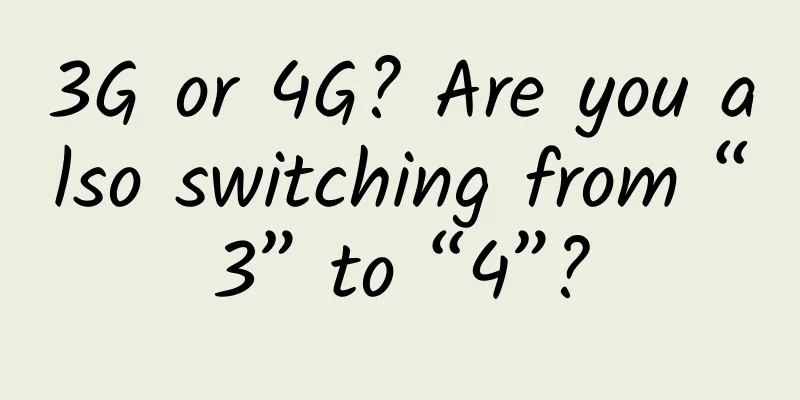3G or 4G? Are you also switching from “3” to “4”?

|
4G has been around for some time. Since the Ministry of Industry and Information Technology issued 4G licenses in December last year, China Mobile was the first to commercialize it on a large scale, and then China Unicom and China Telecom officially piloted hybrid 4G networks in 16 cities in June this year. At least for users in Shanghai, it only takes a few minutes to replace a 4G chip. However, compared with the hard work of operators and terminal manufacturers, consumers are either on the sidelines or confused about 4G. Is the network speed fast? Is the fee expensive? Is it necessary to change? The above uncertainties make most consumers stop at 3G. In response to these issues, the reporter recently conducted field tests on the 4G network in some areas of Shanghai to find out the 4G signal coverage, actual network speed, 4G monthly traffic and monthly charges. Measured route 1: Tianshan Road, Yan'an Elevated Road, Lujiazui, North-South Elevated Road, Lupu Bridge Mature outdoor coverage in the city center with a maximum bandwidth of 70.46Mbps Judging from the results of 4G network operation around the world, 4G network speed is roughly 10 times faster than 3G network. Fu Liang, a senior analyst in the telecommunications industry, told reporters that under 4G network, a bandwidth value of more than 10 is enough to achieve smooth video viewing and other application operations. If it reaches more than 50, the speed is already quite fast. So let's take a look at the actual situation? On the afternoon of August 16, the reporter drove a 4G customized iPhone 5S on Tianshan Road in Changning District and opened the Youku HD version of "Where Are We Going, Dad?". The video started playing smoothly immediately without waiting for cache. At this time, the car had already entered the vicinity of Kaixuan Road, Yan'an West Road. The Speedtest speed test software and Tencent network speed tester were opened, and the server in Shanghai was selected as the speed test point. The bandwidth measured by the former was 36.16Mbps, which is 4.52MB/s when converted into real-time network speed. The average network speed measured by Tencent was 3.38MB/s. According to the test route of the day, it is planned to go east along the Yan'an Road Elevated Road, pass the Yan'an East Road Tunnel to Lujiazui, and then return to Puxi along the original route to take the North-South Elevated Road, pass the Lupu Bridge and arrive at the Oriental Sports Center on the north side of the Central Ring Elevated Road. The whole journey is nearly 30 kilometers and takes more than 1 hour. In the Puxi Yan'an Road Elevated Section, the 4G network signal is always very stable, mostly maintained at 3-4 grids (full grid is 5 grids). At the six speed test points of Kaixuan Road ramp, Jiangsu Road, East China Hospital, Jiuguang Department Store, Shanghai Exhibition Center, and Xizang South Road, the average network speed measured by Speedtest is 2.84MB/s, which is equivalent to a bandwidth of 22.7Mbps. After entering Lujiazui in Pudong, the 4G signal became unstable for the first time. "Where Are We Going, Dad?" was stuck for a while, but it returned to normal after a few seconds. At Century Avenue, IFC, and Shanghai World Financial Center in Lujiazui, Tencent measured an average network speed of 2.5MB/s, while Speedtest measured a network speed of 2.28MB/s, equivalent to a bandwidth of 18.23Mbps. The two data are very close. From the north-south elevated road toward the Lupu Bridge, you can basically see the 4G network speed "showing its prowess". At several speed measurement points along the way, the highest bandwidth reached 70.46Mbps (at the Jiangnan Shipyard Building), about 8.8MB/s, which is really strong and close to the theoretical peak (100Mbps), which is dozens of times that of 3G network. The lowest bandwidth is also 27.19Mbps (Xujiahui Road, north-south elevated road), which is equivalent to a network speed of 3.4MB/s. After that, from the exit of Yaohua Road, turn right at Jingjiyang Road and Yangsi West Road and enter Yaoti Road to reach the Oriental Sports Center, and the 4G network speed remains at a high level all the way. It is worth mentioning that the car passed through the Yan'an East Road Tunnel twice, and the signal in this expected "4G blind spot" was unexpectedly good. Most of the more than 2-kilometer-long tunnel is built under the Huangpu River, but from the entrance to the exit, except for the 100-meter distance in the middle where the 4G signal showed 3 bars, the rest of the time remained full. In the tunnel, "Where Are We Going, Dad?" was also broadcast smoothly. The reporter also dragged and dropped the video at will, but it could be played almost immediately without waiting for the cache, achieving the "second opening" of 720P high-definition video. Conclusion: From the reporter's actual experience, the 4G network outdoor coverage in the commercial and residential areas of Shanghai's central areas, whether in Puxi or Pudong, is very mature. In this test, there was no 4G signal blind spot. At the same time, in actual use, the 4G network also performed without any pressure in the face of daily challenges such as social networking and video. Measured route 2: Nanjing East Road, Zhongshan Park, Jing'an Temple, Xujiahui Indoor coverage is slightly worse and 4G signal is intermittent Since the outdoor coverage of 4G network is excellent, is the indoor network speed also good? The reporter chose several busy areas in downtown Shanghai for testing. There are many office buildings and shopping malls around them, and the density of people is very high. They are all important commercial centers in Shanghai. It is natural to test 4G signals in such a large population flow area. Location 1: Shops along Nanjing East Road Walking in the middle of Nanjing East Road Pedestrian Street, the 4G signal was in good condition all the way. Entering several shops along the north side of the street, although the 4G signal dropped, it was still not a problem to receive the signal. The reporter tested it in a watch shop, and the bandwidth was 25.66Mbps, and the upload speed was 5.02Mbps. However, what the reporter did not expect was that on the south side of the pedestrian street, which was only separated by a road, the 4G signal was sometimes available and sometimes not. The reporter went to a fast food restaurant on the south side and found that the 4G signal was not available, but the 3G and 2G signals were available normally. Location 2: The underground coffee shop in Zhongshan Park and the main entrance of the Dragon Dream shopping mall near Zhongshan Park have very fast 4G network speeds. The reporter measured a bandwidth of 55.67Mbps and a full signal. But after a few steps into the ground floor of the shopping mall, the 4G signal immediately dropped to 3 bars. The reporter then went to the underground floor. As the escalator descended, the 4G signal gradually became unstable, and only 1 bar remained when it reached the B1 floor. This situation lasted for a few seconds, and when the reporter continued to take the escalator to the B2 floor, the 4G signal finally dropped and automatically switched to 3G status. After that, in a coffee shop on the B2 floor, the reporter tried to connect to the 4G signal many times, but failed. Location 3: Jing'an Temple Office Building is located in the Yueyang International Plaza at Changde Road and Nanjing West Road. It is 50 stories high and has nearly 20 companies, most of which are foreign companies. The reporter first came to the 20th floor of the building as a visitor. During the previous elevator ascent, the 4G signal was always weak. However, after exiting the elevator and entering the corporate office area, the 4G signal immediately jumped to three grids, and the bandwidth was measured at this time to be 16.22Mbps. On the 45th floor, the reporter measured a similar 4G network speed in the office area and downloaded a 25M video on the spot, which took nearly 50 seconds. Location 4: Xujiahui Shopping Mall In Xujiahui Grand Gateway and Pacific Department Store, the strength of 4G signals is similar—the signal performance on the ground floor is good, but there is a certain degree of signal attenuation on the second floor and B1 floor. The data measured by the reporter in the two shopping malls show that on the other floors except the ground floor, the highest 4G bandwidth is 12.69Mbps and the lowest is 6.71Mbps, and some corners are 4G signal blind spots. So will the signal attenuation be more severe as the floor is higher? Fortunately, according to the test results, the performance of 4G signals on the 6th and 7th floors is similar to that on the B1 floor or the second floor, and there is no big fluctuation. Conclusion: Compared with the outdoor coverage of 4G network, the indoor coverage is obviously a little worse, and the download speed is also far from the "download a high-definition movie in one minute" in 4G propaganda. After actual measurement and comparison, the reporter found that the indoor network speed of 4G is still several times faster than that of 3G network. For example, on the second floor of Grand Gateway 360, the reporter measured the average bandwidth of 1.68Mbps using 3G network. At the same location and time, the download speed of 4G network is about 8 times faster. Scenario simulation test three: If the monthly consumption of 4G data is close to 200 yuan Now we can be sure that 4G network speed is really fast. So will the exponential growth of traffic make users accidentally encounter sky-high bills? The reporter found a local 4G user as an example to see how fast 4G traffic "runs" and whether the price is expensive. Xiaojun, who works in a central enterprise in Shanghai, is a fashionista who is eager to try out the newly launched 4G. In the first half of this year, she was about to change her mobile phone and bought a 4G version of Galaxy S5 without hesitation. Xiaojun works as a clerical worker in the company, working from 9 to 5, and her work schedule is no different from that of ordinary white-collar workers. She is not overly dependent on mobile phones and uses them normally. Therefore, it is quite valuable to use her as an example to test the daily traffic usage of 4G. Based on Xiaojun's description, the reporter used a traffic statistics application to simulate and calculate each link of her traffic usage on a certain day. Except for the case of Wifi, it was found that her daily traffic consumption was about 147M. If accumulated over a month, the monthly traffic consumption would be about 4G. 8:00 I browsed WeChat Moments and viewed a few pictures, using 198K of data. 8:15-8:45 I browsed a few news reports on Sohu News, and then started reading online novels. The two consumed a total of 2.1M. 9:00-10:00 I browsed Moments and chatted with friends on WeChat for a few minutes, using 314K. 10:00-11:30 I browsed Taobao on my mobile phone and placed an order to complete a payment, using 35M. 11:30-13:00 During lunch break, I cached an episode of a variety show through video software. The video size is about 100M. 14:00-15:00 I received two emails on my mobile phone and previewed the attachments, which cost 507K. 16:00-18:00 Browsing the "friend circle", chatting on WeChat for a while, 1.3M18:00-19:00 On the way home from get off work, I read online novels and played games, which consumed a total of 8M of data. Conclusion: Let's compare the 4G data package standards of China Mobile, China Unicom, and China Telecom. According to the calculation results, the monthly expenditure for consuming 4G traffic is more than 338 yuan (China Mobile), 296 yuan (China Unicom), and 299 yuan (China Telecom). These fees include voice call charges of different lengths. In this way, although the unit price of traffic is lower than that of the 3G era, the total monthly cost of 4G network is still not cheap. Xiaojun said that her monthly service fee is nearly 200 yuan. She believes that online video is the most data-intensive daily application, and the high cost of 4G is mainly due to this. But she admits that although 4G is expensive, the video viewing experience is indeed incomparable to the 3G era. Analysis: 70% of respondents are worried about high tariffs The difficulty of replacing mobile phones and the lack of innovative applications have also been criticized. The 4G war, the competition between the three major operators has just begun. Among them, China Mobile, which has enjoyed a "window period" of 4G competition, has developed particularly fast, but the growth of users is tepid. According to China Mobile data, in July, the number of 4G users was 6.494 million, and the growth rate slowed down to 11.3%, and the total number of 4G customers reached 20.457 million. It took more than half a year for the number of users to exceed 20 million. This growth rate is not fast compared with China Mobile's goal of more than 50 million 4G users within the year. Respondents think changing mobile phones is "too troublesome" In a user survey initiated by this newspaper, nearly 30% of the respondents still believed that changing mobile phones was "too troublesome." Wang Jian, senior analyst at Analysys, told reporters that China's 4G is far from entering a period of rapid development. China Mobile is the only operator that has launched large-scale 4G commercial services nationwide, while the other two operators are only conducting pilot projects in certain cities. Therefore, during this period of market cultivation, user awareness of 4G and market acceptance are key. "The growth of 4G users each quarter is not fast, but it is not slow either." From 3G to 4G, there is a natural barrier for consumers: changing to a 4G mobile phone. Although there are many 4G terminals on the market, and almost all mainstream terminal brands have corresponding 4G models, the prices cover the middle, low and high levels, and there are many thousand-yuan phones. However, in the user survey initiated by this newspaper, nearly 30% of the respondents still think that changing mobile phones is "too troublesome". "This is also one of the reasons why the promotion of 4G will not be achieved overnight." Wang said that in fact, there is also the problem of mobile phone replacement in the process from 2G to 3G, and the latter was also questioned by consumers in the initial stage. "The 3G network has been developed for 5 years, but its national penetration rate is only 40-50%. It took nearly 10 years for foreign countries to issue 3G licenses to issue 4G licenses, while it took us less than half the time. "Therefore, even the application of 3G network will take longer to expand, not to mention that 4G has just started." The high total fee is the user's "demon" The survey results initiated by this newspaper show that nearly 70% of the respondents are worried that 4G traffic is too fast, resulting in too high total charges. Do you still remember the complaints that "the house belongs to the operator after 4G is turned on for one night"? Although the truth is far from that exaggerated, the impression that 4G charges are expensive is still engraved in the minds of users. In the operators' 4G promotion, there has always been a saying that "4G charges are cheaper than 3G". But this is only in terms of unit price. Take China Unicom as an example. Its 3G Internet and voice package with 400M traffic is 126 yuan/month, while the 4G package with the same traffic is 76 yuan/month. In addition, the unit price of 4G traffic outside the package is 0.29-0.3 yuan/M, which is also the same as 3G. In May this year, China Mobile lowered its 4G tariff by up to 50%, also aiming to lower the price of mobile Internet traffic. Although this series of measures to lower the threshold of 4G tariffs shows the determination of operators to quickly stimulate the 4G market, in general, no matter how much talk time and traffic the 4G packages include at this stage, the key is that the total price is still very high. The survey results initiated by this newspaper show that nearly 70% of the respondents are worried that 4G traffic is too fast, so that the total fee is too high. At the same time, nearly 70% of users hope that the monthly cost of mobile data can be controlled below 100 yuan. Taking the above-mentioned Xiaojun's usage as an example, his monthly traffic on the 4G network is about 4G. After the reporter asked several 4G users, he found that the most "economical" monthly traffic is also around 2G. It is not difficult to find that the 4G monthly fee of hundreds of yuan is obviously not in line with the original intention of most users, and not all users can afford it. Lack of groundbreaking “killer” applications There are no more "4G-independent" applications to highlight its advantages in network speed. An operator source told reporters, "The change from 2G to 3G is from voice to Internet, while the change from 3G to 4G is from two lanes to four lanes, there is no qualitative change." From the current perspective, the upgrade from 3G to 4G is indeed more like a network speed-up. Compared with the 3G era, users' usage habits of mobile phones and applications have not changed significantly, and they are still mainly social, video, games and reading. In addition to faster speeds, there are no "killer applications". This is also a major reason why users are too lazy to switch to 4G. However, quantitative change can also lead to qualitative change. Many industry insiders, including Wang Ran, believe that faster network speeds mean more possibilities. Although at present, the speed advantage of 4G is only reflected in high-definition video applications in daily life, and there are no more "4G-independent" applications to highlight its network speed advantage. However, in the near future, many applications in life, production and service industries, such as remote video monitoring, mobile medical care, wearable devices, smart cars, etc., will need to be based on higher-speed networks to be realized. Recalling the upgrade of fixed-line networks, from early telephone lines and 56K "modems" to ADSL and then to optical fiber, each speed upgrade has brought about some new applications. From only being able to browse the web, to downloading some simple applications, and then to being able to watch videos or high-definition videos, "4G will also bring huge changes to people's lives." Wang said. Reporter's Notes: Is it time to take action on 4G? In terms of hardware conditions, Shanghai's 4G network coverage is actually quite mature now. As of the first half of this year, Shanghai Mobile has opened more than 5,000 4G sites, basically covering the main urban area within the outer ring, suburban urban centers outside the outer ring, and the Shanghai Free Trade Zone; Shanghai Unicom's 4G base stations have exceeded 4,000 as of August; and Shanghai Telecom will also achieve more than 4,500 4G macro base stations by the end of the year, basically completing the full coverage of 4G signals in Shanghai's urban areas. It can be seen that the construction speed of 4G networks is much higher than that of 3G networks in those years. From the perspective of soft conditions, 4G can kill the high traffic consumption of 1G in a blink of an eye, but operators are still stingy and calculate package traffic in units of "M", and most consumers still will not buy it. In the reporter's opinion, the following groups of people may be suitable for or have already invested in 4G. The first is business people who often need high-speed mobile networks. Maybe they often have a large amount of data on their computers or mobile phones that need to be sent to customers urgently, and even if they are on Wifi, it will be as slow as a snail. At this time, 4G network can greatly improve their work efficiency. The second group is online video enthusiasts. Connecting to Wifi to download offline videos and watching them slowly in free time cannot be called "online". People who love watching live broadcasts, "can't live without videos" every day, and have strict requirements on video quality should start using 4G networks as soon as possible. The third group is the pioneers. They do not follow the crowd, love to challenge new things, and are the most likely to be the first to experience the 4G network. Of course, a large number of IT experts are also very likely to be eager to try 4G. In fact, almost everyone will gradually become a 4G user in the future, because the network, mobile phones and packages will gradually develop towards "4G". However, at present, various applications based on 4G networks are obviously not mature, and 4G charges are still high, so ordinary citizens may not need to rush, and we should patiently let 4G fly for a while. As a winner of Toutiao's Qingyun Plan and Baijiahao's Bai+ Plan, the 2019 Baidu Digital Author of the Year, the Baijiahao's Most Popular Author in the Technology Field, the 2019 Sogou Technology and Culture Author, and the 2021 Baijiahao Quarterly Influential Creator, he has won many awards, including the 2013 Sohu Best Industry Media Person, the 2015 China New Media Entrepreneurship Competition Beijing Third Place, the 2015 Guangmang Experience Award, the 2015 China New Media Entrepreneurship Competition Finals Third Place, and the 2018 Baidu Dynamic Annual Powerful Celebrity. |
<<: China Unicom will withdraw 2G base stations in some cities to give up frequencies to 4G
Recommend
It's your car, but not entirely. What are the methods used by manufacturers to remotely lock it? This article will help you avoid pitfalls
The car you buy is not your car, or in other word...
Can the former Android giant, which has suffered consecutive losses, return to its glory by relying on these businesses?
I believe that in recent days, everyone must have...
How to collect UGC content through event promotion operations?
1. How to increase the quantity and conversion ra...
China not only has the "Black Myth Monkey King", but also the "Millennium Floating Turtle"!
There is an ancient myth that the Monkey King was...
Breaking the world record! This time it’s a post-00s generation
Recently, the topic "Post-00s want to break ...
The most comprehensive APP operation and promotion plan!
"I recently published an article [How much d...
A guide to avoiding pitfalls from event promotion plan to implementation!
This article contains four parts: Essentially thi...
A shocking global volcanic eruption! The "pain" and "love" of Mount St. Helens
If you ask which volcano in the United States is ...
What are the functions of the Guangzhou WeChat blind date mini program? How much does it cost to make a matchmaking app?
Nowadays, the ratio of men to women is unbalanced...
Cocos' new solution debuts at BesTV/ARM H5 Forum
On June 18, the BesTV/ARM HTML5 Technology Forum ...
Xiao Xiao Sha "Logical Structure Thinking Camp"
Logic is the law and the basis of all thinking. D...
ZTE's logic for making cars: cars are smartphones on four wheels
Another heavyweight company has joined the car-ma...
Yellow fog warning issued! Affecting 8 provinces, please check this safety guide before going out →
The Central Meteorological Observatory continued ...
CCFA: China Instant Retail Development Report 2022
In recent years, instant retail has developed rap...
What happened to those who loved drinking sparkling water?
In recent years, sparkling water has become incre...









